MA514 Business Finance: Applying Financial Concepts to Investment
VerifiedAdded on 2023/06/11
|12
|2584
|227
Report
AI Summary
This report provides a comprehensive financial analysis, focusing on property price forecasting in Sydney, income growth projections, and mortgage payment evaluations. It assesses a client's capability to achieve their 'Australian dream' by examining savings, loan options, and the impact of insurance premiums on property purchases. The analysis includes calculations for monthly savings, maximum loan amounts, and the effect of varying interest rates on mortgage payments. The report evaluates two loan scenarios: a 20% upfront payment without insurance and a 5% upfront payment with insurance, determining the timeline for property purchase under each condition. It also considers potential risks, such as income changes and government policy shifts, while highlighting the overall effectiveness of the financial plan. Desklib offers similar solved assignments and resources for students.
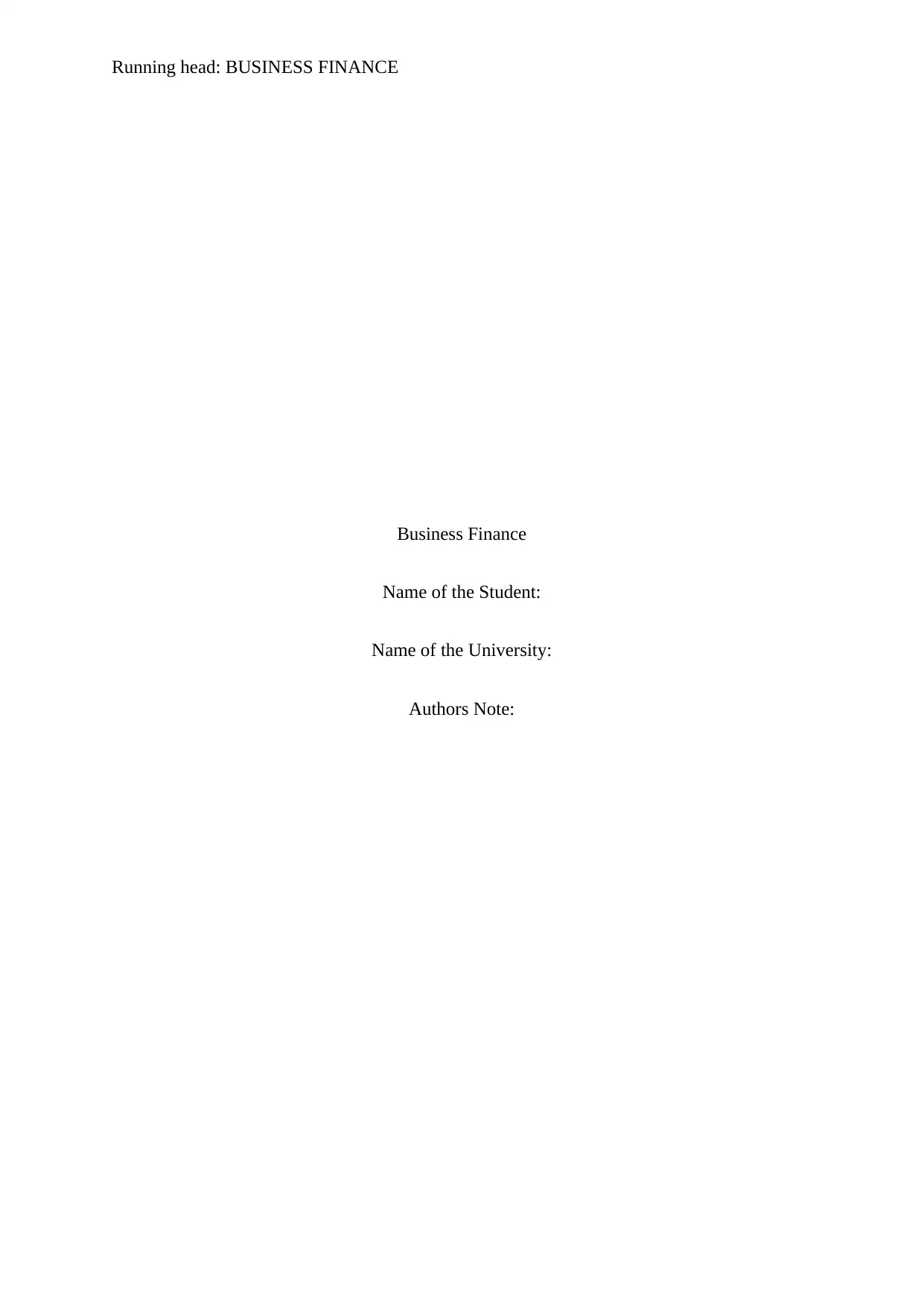
Running head: BUSINESS FINANCE
Business Finance
Name of the Student:
Name of the University:
Authors Note:
Business Finance
Name of the Student:
Name of the University:
Authors Note:
Paraphrase This Document
Need a fresh take? Get an instant paraphrase of this document with our AI Paraphraser
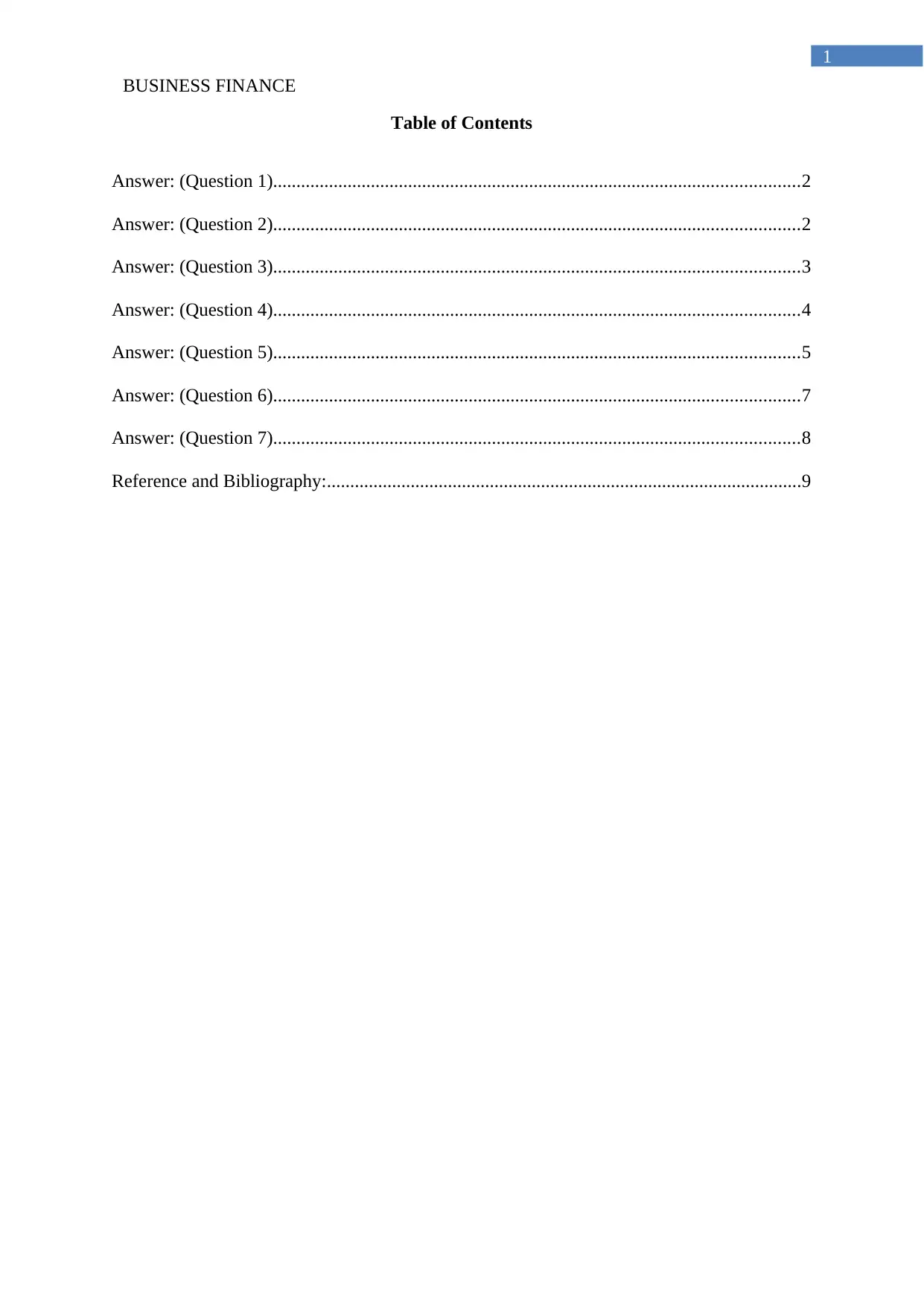
BUSINESS FINANCE
1
Table of Contents
Answer: (Question 1).................................................................................................................2
Answer: (Question 2).................................................................................................................2
Answer: (Question 3).................................................................................................................3
Answer: (Question 4).................................................................................................................4
Answer: (Question 5).................................................................................................................5
Answer: (Question 6).................................................................................................................7
Answer: (Question 7).................................................................................................................8
Reference and Bibliography:......................................................................................................9
1
Table of Contents
Answer: (Question 1).................................................................................................................2
Answer: (Question 2).................................................................................................................2
Answer: (Question 3).................................................................................................................3
Answer: (Question 4).................................................................................................................4
Answer: (Question 5).................................................................................................................5
Answer: (Question 6).................................................................................................................7
Answer: (Question 7).................................................................................................................8
Reference and Bibliography:......................................................................................................9
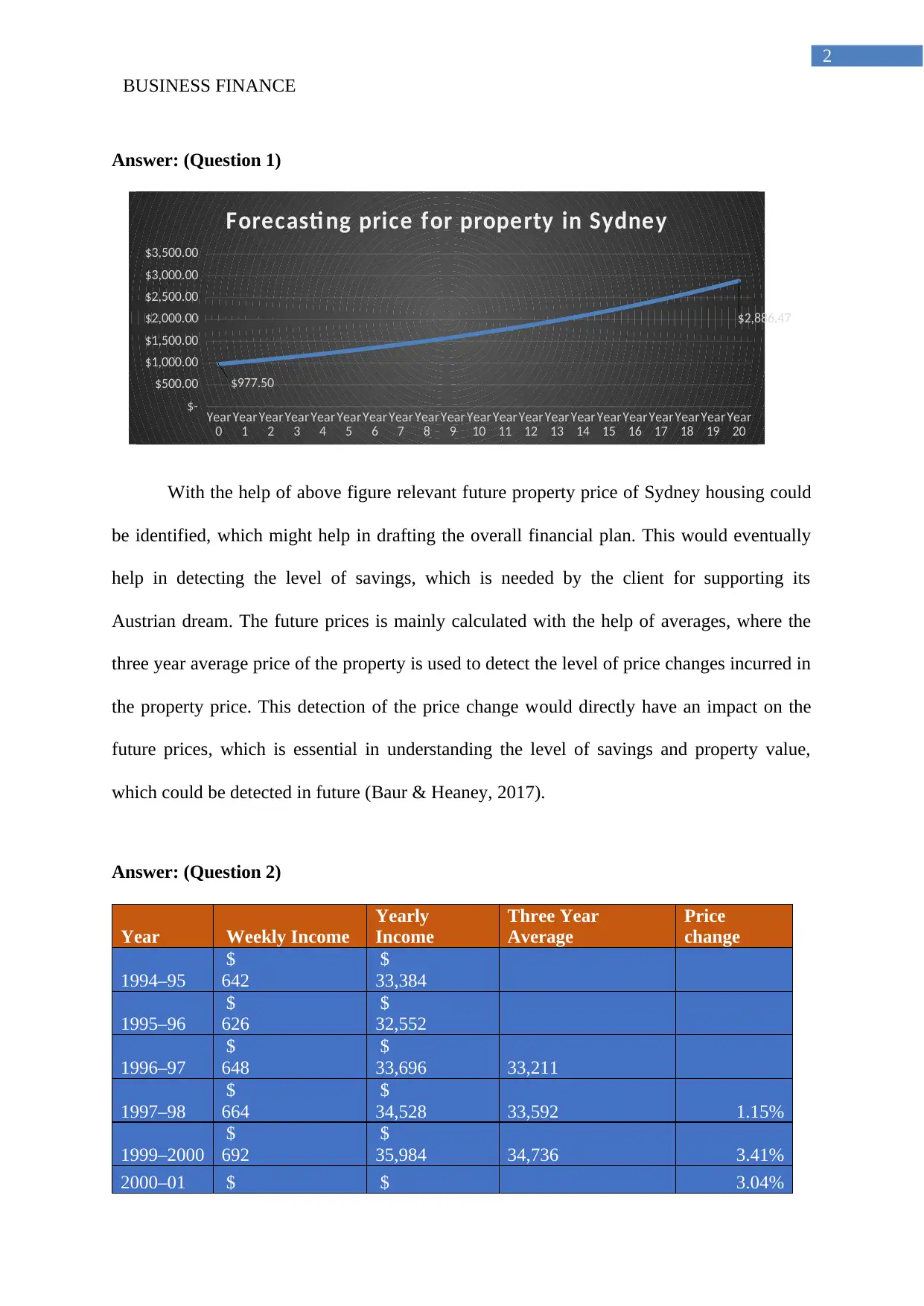
BUSINESS FINANCE
2
Answer: (Question 1)
Year
0 Year
1 Year
2 Year
3 Year
4 Year
5 Year
6 Year
7 Year
8 Year
9 Year
10 Year
11 Year
12 Year
13 Year
14 Year
15 Year
16 Year
17 Year
18 Year
19 Year
20
$-
$500.00
$1,000.00
$1,500.00
$2,000.00
$2,500.00
$3,000.00
$3,500.00
$977.50
$2,886.47
Forecasti ng price for property in Sydney
With the help of above figure relevant future property price of Sydney housing could
be identified, which might help in drafting the overall financial plan. This would eventually
help in detecting the level of savings, which is needed by the client for supporting its
Austrian dream. The future prices is mainly calculated with the help of averages, where the
three year average price of the property is used to detect the level of price changes incurred in
the property price. This detection of the price change would directly have an impact on the
future prices, which is essential in understanding the level of savings and property value,
which could be detected in future (Baur & Heaney, 2017).
Answer: (Question 2)
Year Weekly Income
Yearly
Income
Three Year
Average
Price
change
1994–95
$
642
$
33,384
1995–96
$
626
$
32,552
1996–97
$
648
$
33,696 33,211
1997–98
$
664
$
34,528 33,592 1.15%
1999–2000
$
692
$
35,984 34,736 3.41%
2000–01 $ $ 3.04%
2
Answer: (Question 1)
Year
0 Year
1 Year
2 Year
3 Year
4 Year
5 Year
6 Year
7 Year
8 Year
9 Year
10 Year
11 Year
12 Year
13 Year
14 Year
15 Year
16 Year
17 Year
18 Year
19 Year
20
$-
$500.00
$1,000.00
$1,500.00
$2,000.00
$2,500.00
$3,000.00
$3,500.00
$977.50
$2,886.47
Forecasti ng price for property in Sydney
With the help of above figure relevant future property price of Sydney housing could
be identified, which might help in drafting the overall financial plan. This would eventually
help in detecting the level of savings, which is needed by the client for supporting its
Austrian dream. The future prices is mainly calculated with the help of averages, where the
three year average price of the property is used to detect the level of price changes incurred in
the property price. This detection of the price change would directly have an impact on the
future prices, which is essential in understanding the level of savings and property value,
which could be detected in future (Baur & Heaney, 2017).
Answer: (Question 2)
Year Weekly Income
Yearly
Income
Three Year
Average
Price
change
1994–95
$
642
$
33,384
1995–96
$
626
$
32,552
1996–97
$
648
$
33,696 33,211
1997–98
$
664
$
34,528 33,592 1.15%
1999–2000
$
692
$
35,984 34,736 3.41%
2000–01 $ $ 3.04%
⊘ This is a preview!⊘
Do you want full access?
Subscribe today to unlock all pages.

Trusted by 1+ million students worldwide

BUSINESS FINANCE
3
709 36,868 35,793
2002–03
$
726
$
37,752 36,868 3.00%
2003–
04(a)
$
806
$
41,912 38,844 5.36%
2005–
06(a)
$
870
$
45,240 41,635 7.18%
2007–
08(a)
$
994
$
51,688 46,280 11.16%
2009–
10(a)
$
981
$
51,012 49,313 6.55%
2011–
12(a)
$
1,015
$
52,780 51,827 5.10%
2013–
14(a)
$
1,046
$
54,392 52,728 1.74%
2015–
16(a)
$
1,070
$
55,640 54,271 2.93%
Average 4.60%
Year
0 Year
1 Year
2 Year
3 Year
4 Year
5 Year
6 Year
7 Year
8 Year
9 Year
10 Year
11 Year
12 Year
13 Year
14 Year
15 Year
16 Year
17 Year
18 Year
19 Year
20
$-
$50.00
$100.00
$150.00
$200.00
$250.00
$80.00
$196.72
Forecasting growth of Clinet
The evaluation of above graph helps in understanding the level of income growth
which will incur by the client in 20 years’ time. The income growth calculation is mainly
valued with the help of average valuation, which is obtained by the salaried persons in
Sydney. Therefore, the calculation is mainly conducted with the help of previous 20 years of
income that is generated by salaried person in Sydney, which could help in understanding the
level of income. The income of client is anticipated to increase from $80,000 to 196,720 in
20 years’ time, which will be helpful in drafting the financial plan. This financial plan would
3
709 36,868 35,793
2002–03
$
726
$
37,752 36,868 3.00%
2003–
04(a)
$
806
$
41,912 38,844 5.36%
2005–
06(a)
$
870
$
45,240 41,635 7.18%
2007–
08(a)
$
994
$
51,688 46,280 11.16%
2009–
10(a)
$
981
$
51,012 49,313 6.55%
2011–
12(a)
$
1,015
$
52,780 51,827 5.10%
2013–
14(a)
$
1,046
$
54,392 52,728 1.74%
2015–
16(a)
$
1,070
$
55,640 54,271 2.93%
Average 4.60%
Year
0 Year
1 Year
2 Year
3 Year
4 Year
5 Year
6 Year
7 Year
8 Year
9 Year
10 Year
11 Year
12 Year
13 Year
14 Year
15 Year
16 Year
17 Year
18 Year
19 Year
20
$-
$50.00
$100.00
$150.00
$200.00
$250.00
$80.00
$196.72
Forecasting growth of Clinet
The evaluation of above graph helps in understanding the level of income growth
which will incur by the client in 20 years’ time. The income growth calculation is mainly
valued with the help of average valuation, which is obtained by the salaried persons in
Sydney. Therefore, the calculation is mainly conducted with the help of previous 20 years of
income that is generated by salaried person in Sydney, which could help in understanding the
level of income. The income of client is anticipated to increase from $80,000 to 196,720 in
20 years’ time, which will be helpful in drafting the financial plan. This financial plan would
Paraphrase This Document
Need a fresh take? Get an instant paraphrase of this document with our AI Paraphraser
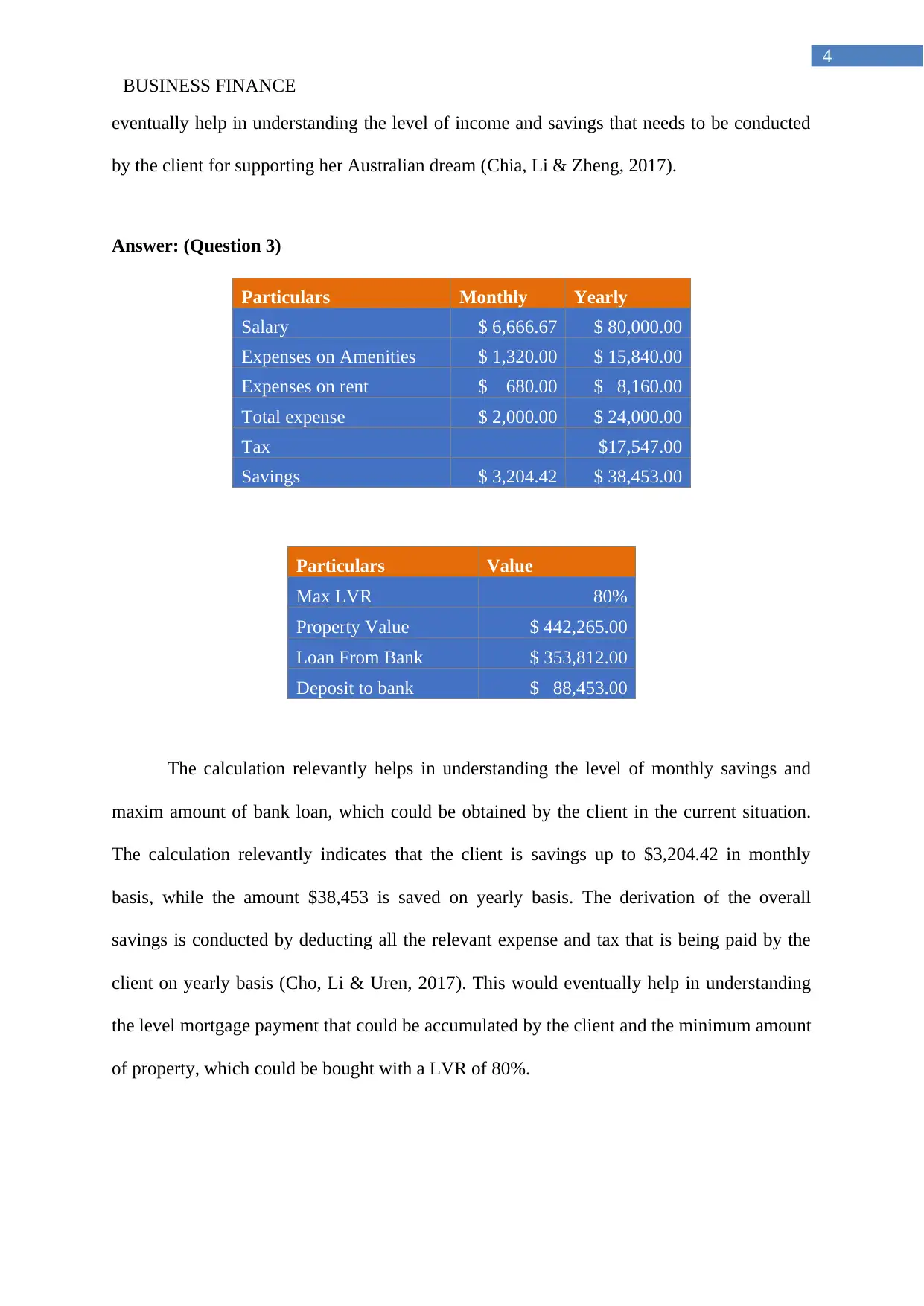
BUSINESS FINANCE
4
eventually help in understanding the level of income and savings that needs to be conducted
by the client for supporting her Australian dream (Chia, Li & Zheng, 2017).
Answer: (Question 3)
Particulars Monthly Yearly
Salary $ 6,666.67 $ 80,000.00
Expenses on Amenities $ 1,320.00 $ 15,840.00
Expenses on rent $ 680.00 $ 8,160.00
Total expense $ 2,000.00 $ 24,000.00
Tax $17,547.00
Savings $ 3,204.42 $ 38,453.00
Particulars Value
Max LVR 80%
Property Value $ 442,265.00
Loan From Bank $ 353,812.00
Deposit to bank $ 88,453.00
The calculation relevantly helps in understanding the level of monthly savings and
maxim amount of bank loan, which could be obtained by the client in the current situation.
The calculation relevantly indicates that the client is savings up to $3,204.42 in monthly
basis, while the amount $38,453 is saved on yearly basis. The derivation of the overall
savings is conducted by deducting all the relevant expense and tax that is being paid by the
client on yearly basis (Cho, Li & Uren, 2017). This would eventually help in understanding
the level mortgage payment that could be accumulated by the client and the minimum amount
of property, which could be bought with a LVR of 80%.
4
eventually help in understanding the level of income and savings that needs to be conducted
by the client for supporting her Australian dream (Chia, Li & Zheng, 2017).
Answer: (Question 3)
Particulars Monthly Yearly
Salary $ 6,666.67 $ 80,000.00
Expenses on Amenities $ 1,320.00 $ 15,840.00
Expenses on rent $ 680.00 $ 8,160.00
Total expense $ 2,000.00 $ 24,000.00
Tax $17,547.00
Savings $ 3,204.42 $ 38,453.00
Particulars Value
Max LVR 80%
Property Value $ 442,265.00
Loan From Bank $ 353,812.00
Deposit to bank $ 88,453.00
The calculation relevantly helps in understanding the level of monthly savings and
maxim amount of bank loan, which could be obtained by the client in the current situation.
The calculation relevantly indicates that the client is savings up to $3,204.42 in monthly
basis, while the amount $38,453 is saved on yearly basis. The derivation of the overall
savings is conducted by deducting all the relevant expense and tax that is being paid by the
client on yearly basis (Cho, Li & Uren, 2017). This would eventually help in understanding
the level mortgage payment that could be accumulated by the client and the minimum amount
of property, which could be bought with a LVR of 80%.
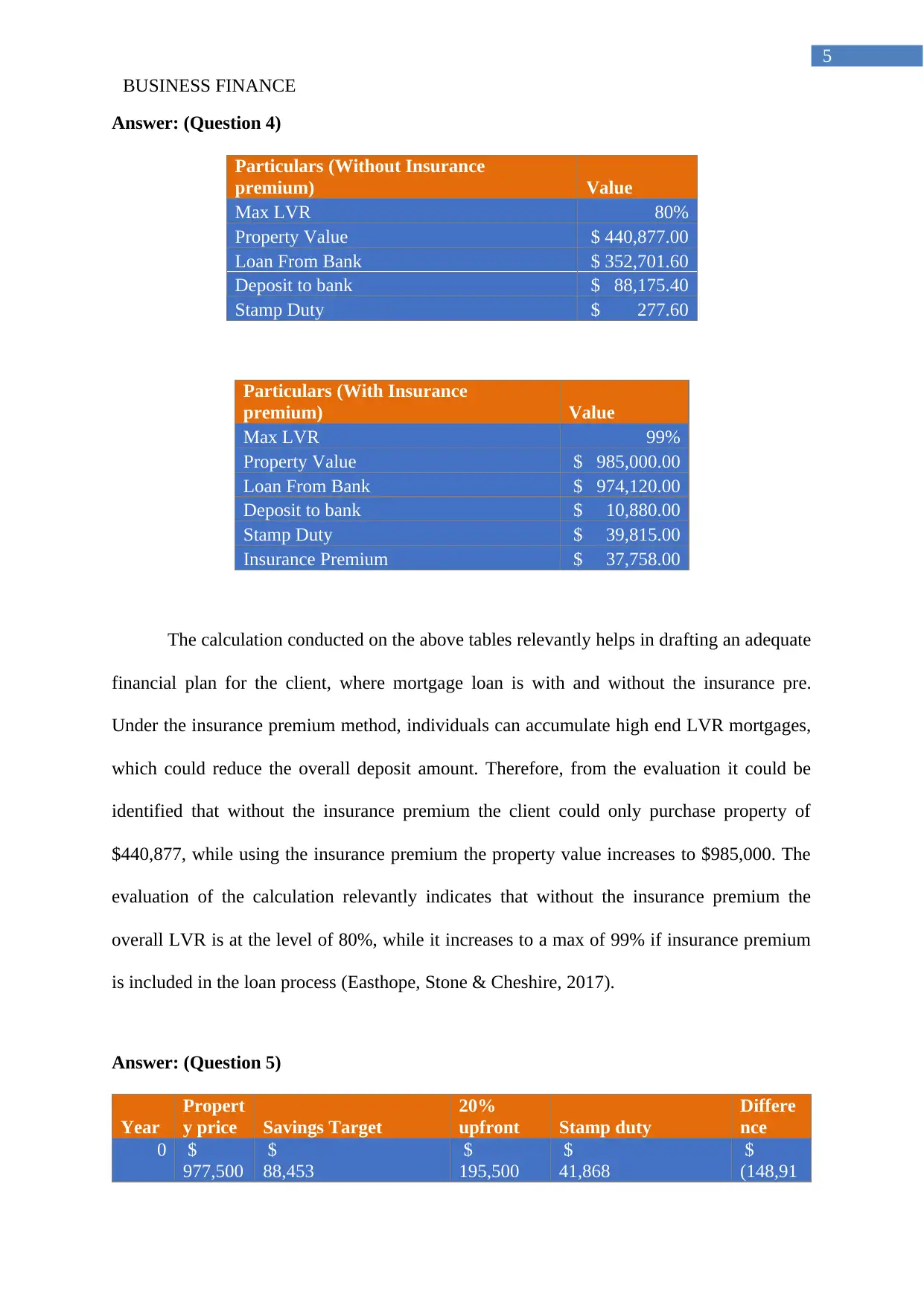
BUSINESS FINANCE
5
Answer: (Question 4)
Particulars (Without Insurance
premium) Value
Max LVR 80%
Property Value $ 440,877.00
Loan From Bank $ 352,701.60
Deposit to bank $ 88,175.40
Stamp Duty $ 277.60
Particulars (With Insurance
premium) Value
Max LVR 99%
Property Value $ 985,000.00
Loan From Bank $ 974,120.00
Deposit to bank $ 10,880.00
Stamp Duty $ 39,815.00
Insurance Premium $ 37,758.00
The calculation conducted on the above tables relevantly helps in drafting an adequate
financial plan for the client, where mortgage loan is with and without the insurance pre.
Under the insurance premium method, individuals can accumulate high end LVR mortgages,
which could reduce the overall deposit amount. Therefore, from the evaluation it could be
identified that without the insurance premium the client could only purchase property of
$440,877, while using the insurance premium the property value increases to $985,000. The
evaluation of the calculation relevantly indicates that without the insurance premium the
overall LVR is at the level of 80%, while it increases to a max of 99% if insurance premium
is included in the loan process (Easthope, Stone & Cheshire, 2017).
Answer: (Question 5)
Year
Propert
y price Savings Target
20%
upfront Stamp duty
Differe
nce
0 $
977,500
$
88,453
$
195,500
$
41,868
$
(148,91
5
Answer: (Question 4)
Particulars (Without Insurance
premium) Value
Max LVR 80%
Property Value $ 440,877.00
Loan From Bank $ 352,701.60
Deposit to bank $ 88,175.40
Stamp Duty $ 277.60
Particulars (With Insurance
premium) Value
Max LVR 99%
Property Value $ 985,000.00
Loan From Bank $ 974,120.00
Deposit to bank $ 10,880.00
Stamp Duty $ 39,815.00
Insurance Premium $ 37,758.00
The calculation conducted on the above tables relevantly helps in drafting an adequate
financial plan for the client, where mortgage loan is with and without the insurance pre.
Under the insurance premium method, individuals can accumulate high end LVR mortgages,
which could reduce the overall deposit amount. Therefore, from the evaluation it could be
identified that without the insurance premium the client could only purchase property of
$440,877, while using the insurance premium the property value increases to $985,000. The
evaluation of the calculation relevantly indicates that without the insurance premium the
overall LVR is at the level of 80%, while it increases to a max of 99% if insurance premium
is included in the loan process (Easthope, Stone & Cheshire, 2017).
Answer: (Question 5)
Year
Propert
y price Savings Target
20%
upfront Stamp duty
Differe
nce
0 $
977,500
$
88,453
$
195,500
$
41,868
$
(148,91
⊘ This is a preview!⊘
Do you want full access?
Subscribe today to unlock all pages.

Trusted by 1+ million students worldwide
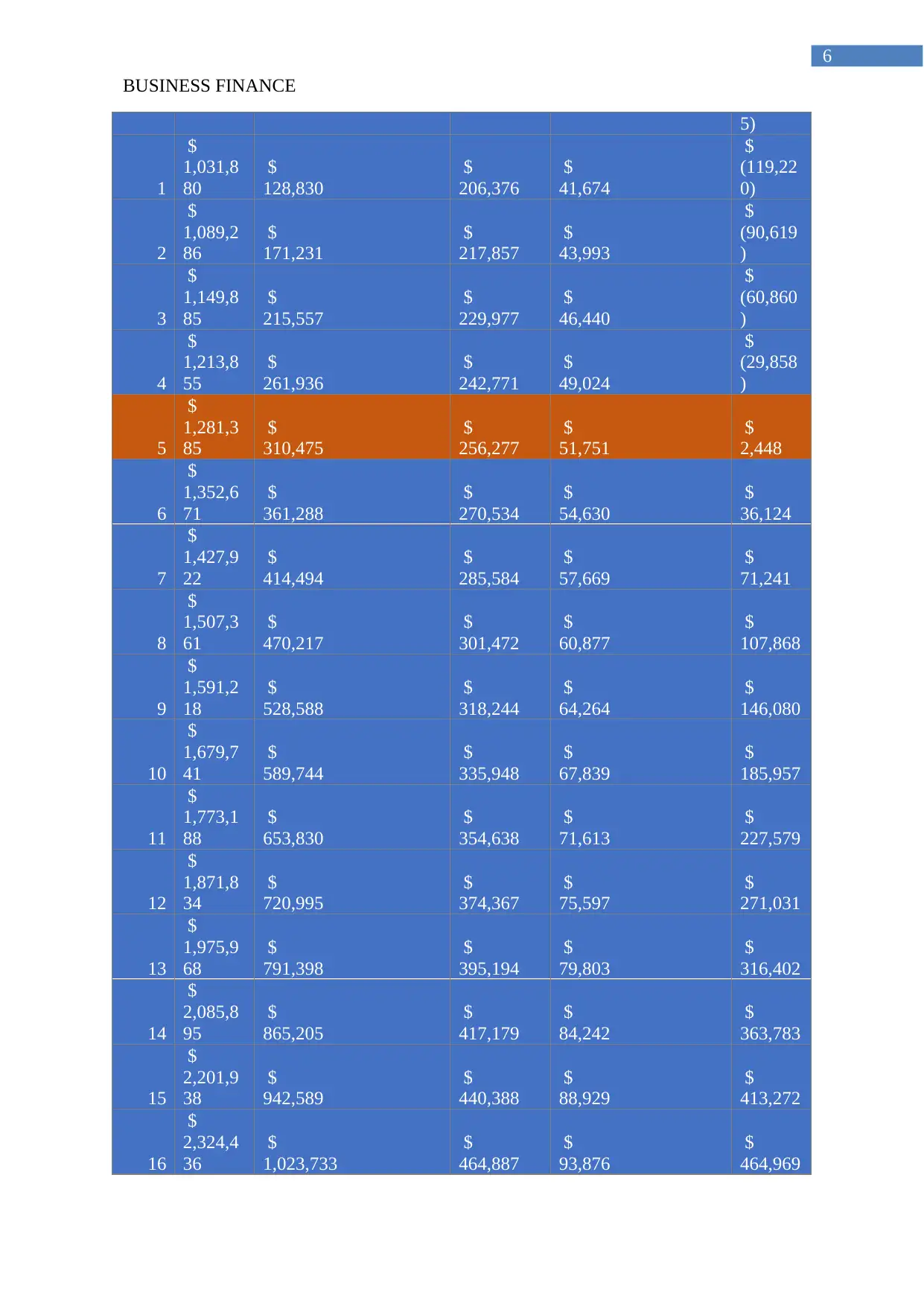
BUSINESS FINANCE
6
5)
1
$
1,031,8
80
$
128,830
$
206,376
$
41,674
$
(119,22
0)
2
$
1,089,2
86
$
171,231
$
217,857
$
43,993
$
(90,619
)
3
$
1,149,8
85
$
215,557
$
229,977
$
46,440
$
(60,860
)
4
$
1,213,8
55
$
261,936
$
242,771
$
49,024
$
(29,858
)
5
$
1,281,3
85
$
310,475
$
256,277
$
51,751
$
2,448
6
$
1,352,6
71
$
361,288
$
270,534
$
54,630
$
36,124
7
$
1,427,9
22
$
414,494
$
285,584
$
57,669
$
71,241
8
$
1,507,3
61
$
470,217
$
301,472
$
60,877
$
107,868
9
$
1,591,2
18
$
528,588
$
318,244
$
64,264
$
146,080
10
$
1,679,7
41
$
589,744
$
335,948
$
67,839
$
185,957
11
$
1,773,1
88
$
653,830
$
354,638
$
71,613
$
227,579
12
$
1,871,8
34
$
720,995
$
374,367
$
75,597
$
271,031
13
$
1,975,9
68
$
791,398
$
395,194
$
79,803
$
316,402
14
$
2,085,8
95
$
865,205
$
417,179
$
84,242
$
363,783
15
$
2,201,9
38
$
942,589
$
440,388
$
88,929
$
413,272
16
$
2,324,4
36
$
1,023,733
$
464,887
$
93,876
$
464,969
6
5)
1
$
1,031,8
80
$
128,830
$
206,376
$
41,674
$
(119,22
0)
2
$
1,089,2
86
$
171,231
$
217,857
$
43,993
$
(90,619
)
3
$
1,149,8
85
$
215,557
$
229,977
$
46,440
$
(60,860
)
4
$
1,213,8
55
$
261,936
$
242,771
$
49,024
$
(29,858
)
5
$
1,281,3
85
$
310,475
$
256,277
$
51,751
$
2,448
6
$
1,352,6
71
$
361,288
$
270,534
$
54,630
$
36,124
7
$
1,427,9
22
$
414,494
$
285,584
$
57,669
$
71,241
8
$
1,507,3
61
$
470,217
$
301,472
$
60,877
$
107,868
9
$
1,591,2
18
$
528,588
$
318,244
$
64,264
$
146,080
10
$
1,679,7
41
$
589,744
$
335,948
$
67,839
$
185,957
11
$
1,773,1
88
$
653,830
$
354,638
$
71,613
$
227,579
12
$
1,871,8
34
$
720,995
$
374,367
$
75,597
$
271,031
13
$
1,975,9
68
$
791,398
$
395,194
$
79,803
$
316,402
14
$
2,085,8
95
$
865,205
$
417,179
$
84,242
$
363,783
15
$
2,201,9
38
$
942,589
$
440,388
$
88,929
$
413,272
16
$
2,324,4
36
$
1,023,733
$
464,887
$
93,876
$
464,969
Paraphrase This Document
Need a fresh take? Get an instant paraphrase of this document with our AI Paraphraser
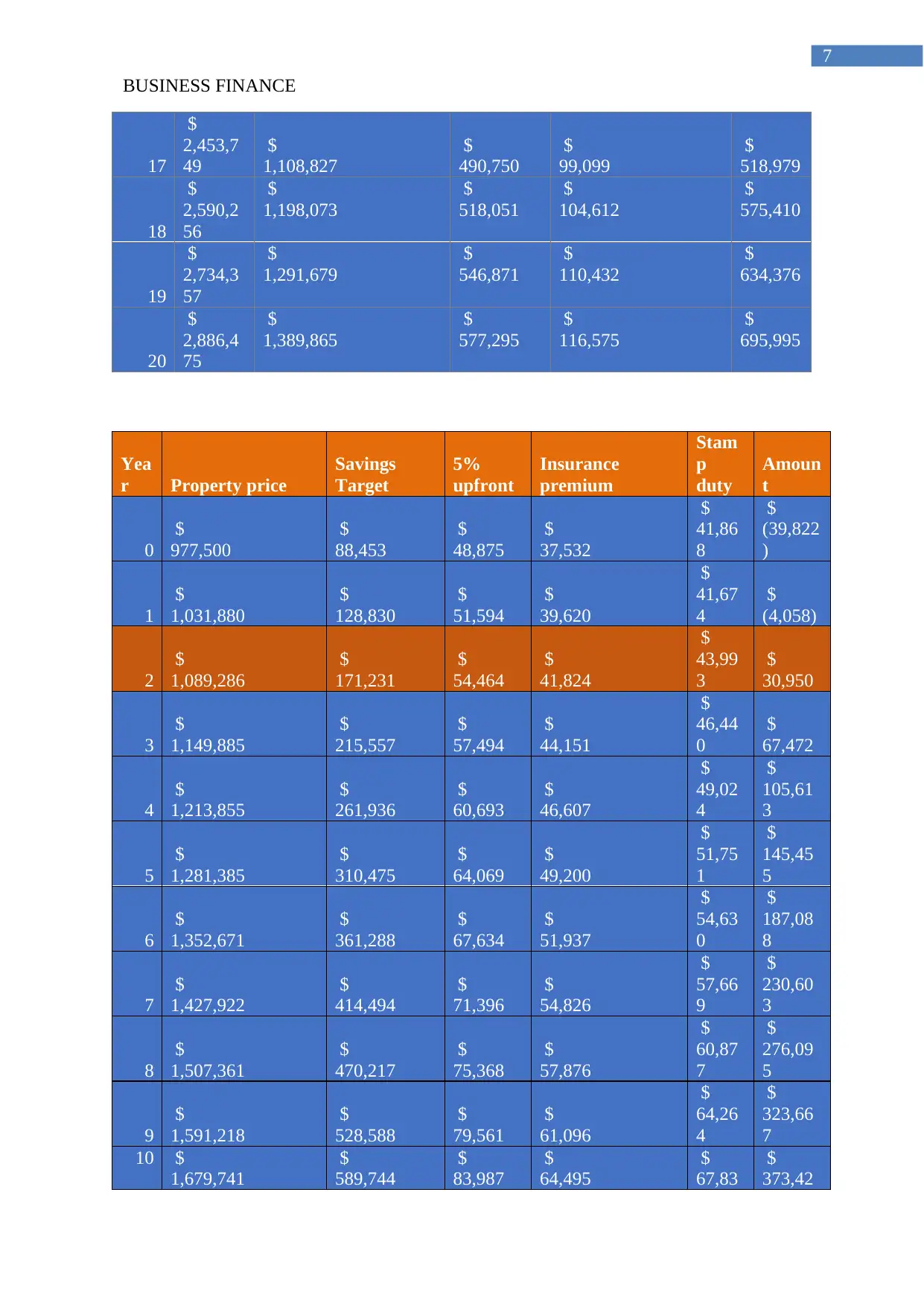
BUSINESS FINANCE
7
17
$
2,453,7
49
$
1,108,827
$
490,750
$
99,099
$
518,979
18
$
2,590,2
56
$
1,198,073
$
518,051
$
104,612
$
575,410
19
$
2,734,3
57
$
1,291,679
$
546,871
$
110,432
$
634,376
20
$
2,886,4
75
$
1,389,865
$
577,295
$
116,575
$
695,995
Yea
r Property price
Savings
Target
5%
upfront
Insurance
premium
Stam
p
duty
Amoun
t
0
$
977,500
$
88,453
$
48,875
$
37,532
$
41,86
8
$
(39,822
)
1
$
1,031,880
$
128,830
$
51,594
$
39,620
$
41,67
4
$
(4,058)
2
$
1,089,286
$
171,231
$
54,464
$
41,824
$
43,99
3
$
30,950
3
$
1,149,885
$
215,557
$
57,494
$
44,151
$
46,44
0
$
67,472
4
$
1,213,855
$
261,936
$
60,693
$
46,607
$
49,02
4
$
105,61
3
5
$
1,281,385
$
310,475
$
64,069
$
49,200
$
51,75
1
$
145,45
5
6
$
1,352,671
$
361,288
$
67,634
$
51,937
$
54,63
0
$
187,08
8
7
$
1,427,922
$
414,494
$
71,396
$
54,826
$
57,66
9
$
230,60
3
8
$
1,507,361
$
470,217
$
75,368
$
57,876
$
60,87
7
$
276,09
5
9
$
1,591,218
$
528,588
$
79,561
$
61,096
$
64,26
4
$
323,66
7
10 $
1,679,741
$
589,744
$
83,987
$
64,495
$
67,83
$
373,42
7
17
$
2,453,7
49
$
1,108,827
$
490,750
$
99,099
$
518,979
18
$
2,590,2
56
$
1,198,073
$
518,051
$
104,612
$
575,410
19
$
2,734,3
57
$
1,291,679
$
546,871
$
110,432
$
634,376
20
$
2,886,4
75
$
1,389,865
$
577,295
$
116,575
$
695,995
Yea
r Property price
Savings
Target
5%
upfront
Insurance
premium
Stam
p
duty
Amoun
t
0
$
977,500
$
88,453
$
48,875
$
37,532
$
41,86
8
$
(39,822
)
1
$
1,031,880
$
128,830
$
51,594
$
39,620
$
41,67
4
$
(4,058)
2
$
1,089,286
$
171,231
$
54,464
$
41,824
$
43,99
3
$
30,950
3
$
1,149,885
$
215,557
$
57,494
$
44,151
$
46,44
0
$
67,472
4
$
1,213,855
$
261,936
$
60,693
$
46,607
$
49,02
4
$
105,61
3
5
$
1,281,385
$
310,475
$
64,069
$
49,200
$
51,75
1
$
145,45
5
6
$
1,352,671
$
361,288
$
67,634
$
51,937
$
54,63
0
$
187,08
8
7
$
1,427,922
$
414,494
$
71,396
$
54,826
$
57,66
9
$
230,60
3
8
$
1,507,361
$
470,217
$
75,368
$
57,876
$
60,87
7
$
276,09
5
9
$
1,591,218
$
528,588
$
79,561
$
61,096
$
64,26
4
$
323,66
7
10 $
1,679,741
$
589,744
$
83,987
$
64,495
$
67,83
$
373,42
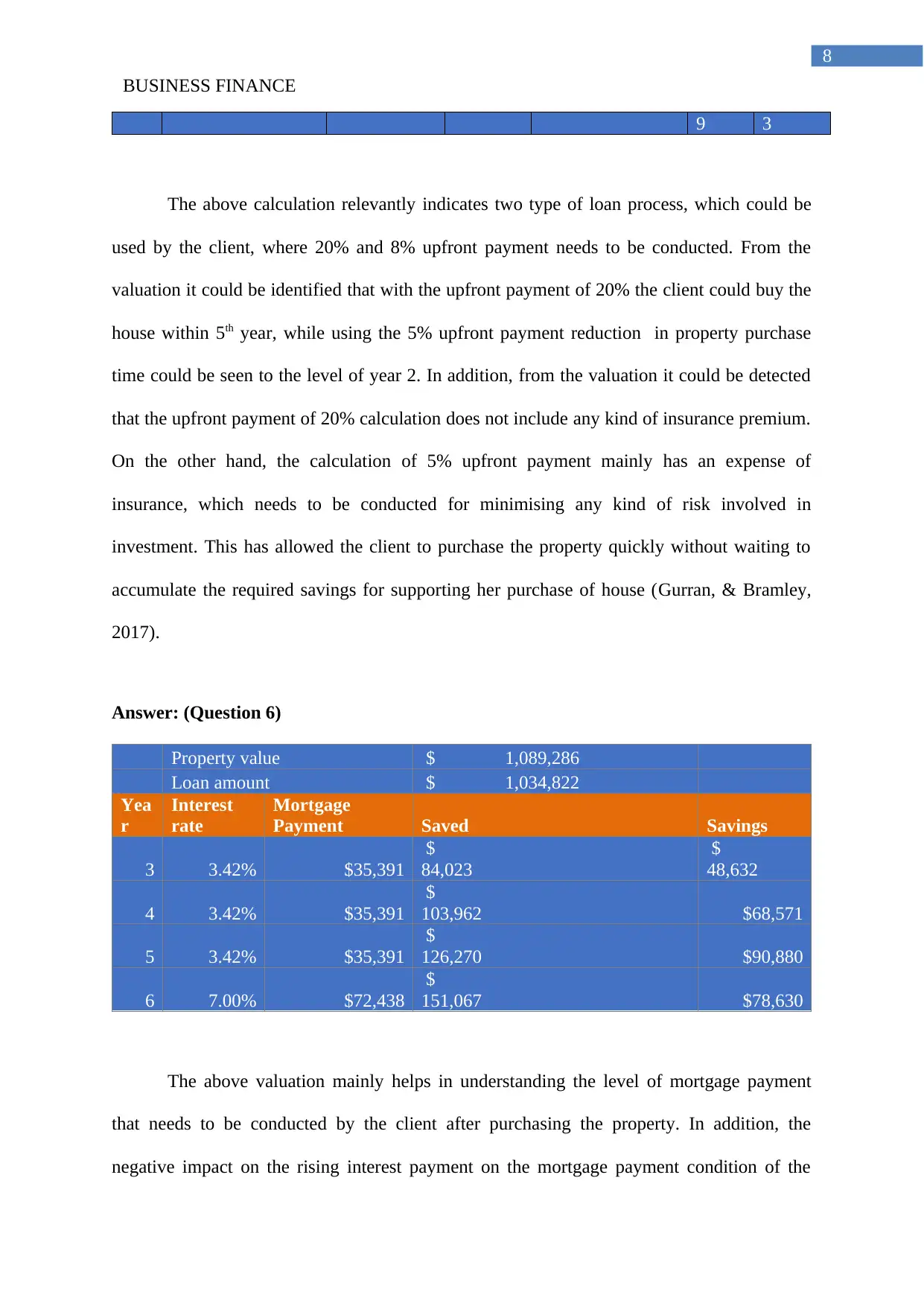
BUSINESS FINANCE
8
9 3
The above calculation relevantly indicates two type of loan process, which could be
used by the client, where 20% and 8% upfront payment needs to be conducted. From the
valuation it could be identified that with the upfront payment of 20% the client could buy the
house within 5th year, while using the 5% upfront payment reduction in property purchase
time could be seen to the level of year 2. In addition, from the valuation it could be detected
that the upfront payment of 20% calculation does not include any kind of insurance premium.
On the other hand, the calculation of 5% upfront payment mainly has an expense of
insurance, which needs to be conducted for minimising any kind of risk involved in
investment. This has allowed the client to purchase the property quickly without waiting to
accumulate the required savings for supporting her purchase of house (Gurran, & Bramley,
2017).
Answer: (Question 6)
Property value $ 1,089,286
Loan amount $ 1,034,822
Yea
r
Interest
rate
Mortgage
Payment Saved Savings
3 3.42% $35,391
$
84,023
$
48,632
4 3.42% $35,391
$
103,962 $68,571
5 3.42% $35,391
$
126,270 $90,880
6 7.00% $72,438
$
151,067 $78,630
The above valuation mainly helps in understanding the level of mortgage payment
that needs to be conducted by the client after purchasing the property. In addition, the
negative impact on the rising interest payment on the mortgage payment condition of the
8
9 3
The above calculation relevantly indicates two type of loan process, which could be
used by the client, where 20% and 8% upfront payment needs to be conducted. From the
valuation it could be identified that with the upfront payment of 20% the client could buy the
house within 5th year, while using the 5% upfront payment reduction in property purchase
time could be seen to the level of year 2. In addition, from the valuation it could be detected
that the upfront payment of 20% calculation does not include any kind of insurance premium.
On the other hand, the calculation of 5% upfront payment mainly has an expense of
insurance, which needs to be conducted for minimising any kind of risk involved in
investment. This has allowed the client to purchase the property quickly without waiting to
accumulate the required savings for supporting her purchase of house (Gurran, & Bramley,
2017).
Answer: (Question 6)
Property value $ 1,089,286
Loan amount $ 1,034,822
Yea
r
Interest
rate
Mortgage
Payment Saved Savings
3 3.42% $35,391
$
84,023
$
48,632
4 3.42% $35,391
$
103,962 $68,571
5 3.42% $35,391
$
126,270 $90,880
6 7.00% $72,438
$
151,067 $78,630
The above valuation mainly helps in understanding the level of mortgage payment
that needs to be conducted by the client after purchasing the property. In addition, the
negative impact on the rising interest payment on the mortgage payment condition of the
⊘ This is a preview!⊘
Do you want full access?
Subscribe today to unlock all pages.

Trusted by 1+ million students worldwide
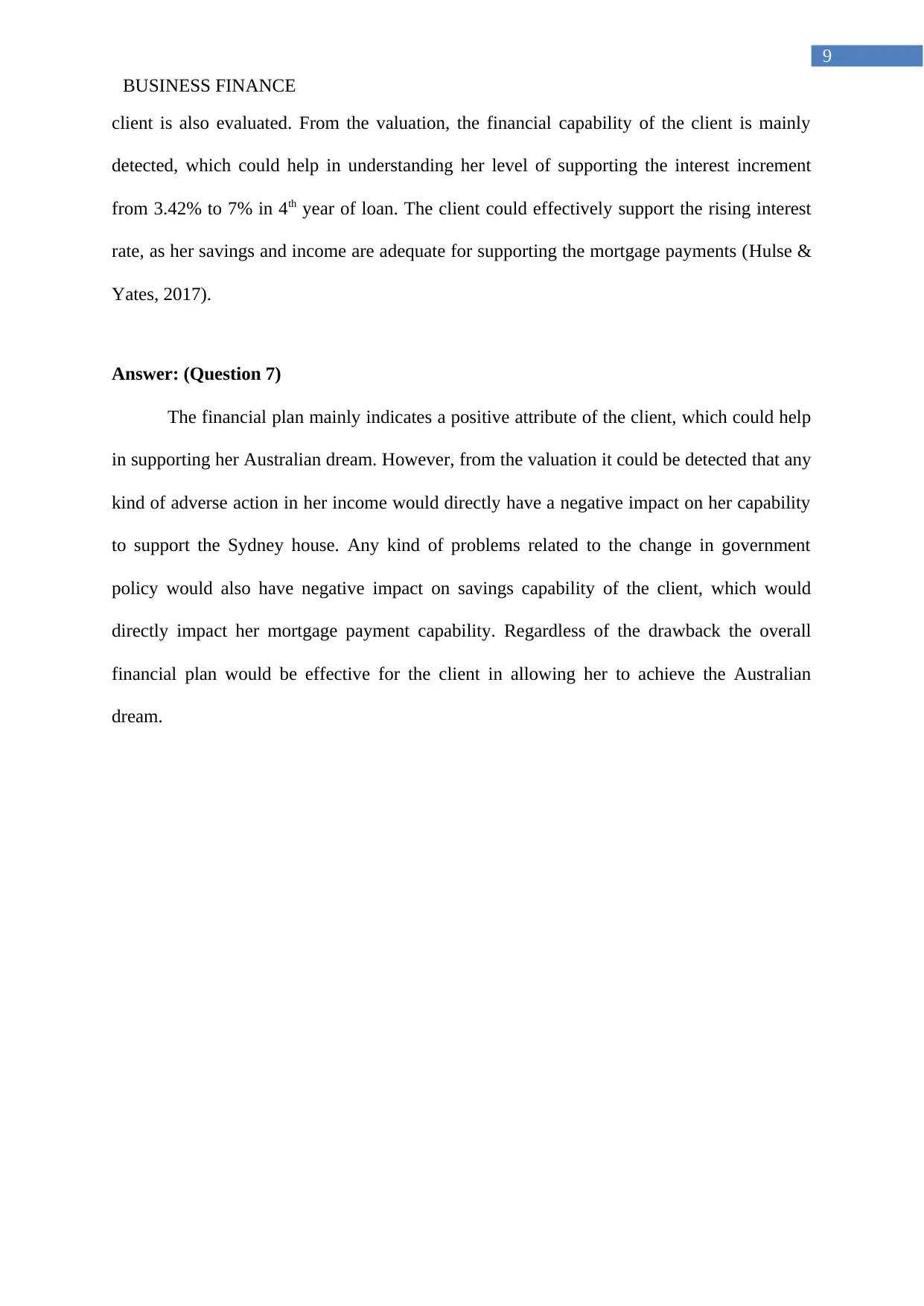
BUSINESS FINANCE
9
client is also evaluated. From the valuation, the financial capability of the client is mainly
detected, which could help in understanding her level of supporting the interest increment
from 3.42% to 7% in 4th year of loan. The client could effectively support the rising interest
rate, as her savings and income are adequate for supporting the mortgage payments (Hulse &
Yates, 2017).
Answer: (Question 7)
The financial plan mainly indicates a positive attribute of the client, which could help
in supporting her Australian dream. However, from the valuation it could be detected that any
kind of adverse action in her income would directly have a negative impact on her capability
to support the Sydney house. Any kind of problems related to the change in government
policy would also have negative impact on savings capability of the client, which would
directly impact her mortgage payment capability. Regardless of the drawback the overall
financial plan would be effective for the client in allowing her to achieve the Australian
dream.
9
client is also evaluated. From the valuation, the financial capability of the client is mainly
detected, which could help in understanding her level of supporting the interest increment
from 3.42% to 7% in 4th year of loan. The client could effectively support the rising interest
rate, as her savings and income are adequate for supporting the mortgage payments (Hulse &
Yates, 2017).
Answer: (Question 7)
The financial plan mainly indicates a positive attribute of the client, which could help
in supporting her Australian dream. However, from the valuation it could be detected that any
kind of adverse action in her income would directly have a negative impact on her capability
to support the Sydney house. Any kind of problems related to the change in government
policy would also have negative impact on savings capability of the client, which would
directly impact her mortgage payment capability. Regardless of the drawback the overall
financial plan would be effective for the client in allowing her to achieve the Australian
dream.
Paraphrase This Document
Need a fresh take? Get an instant paraphrase of this document with our AI Paraphraser
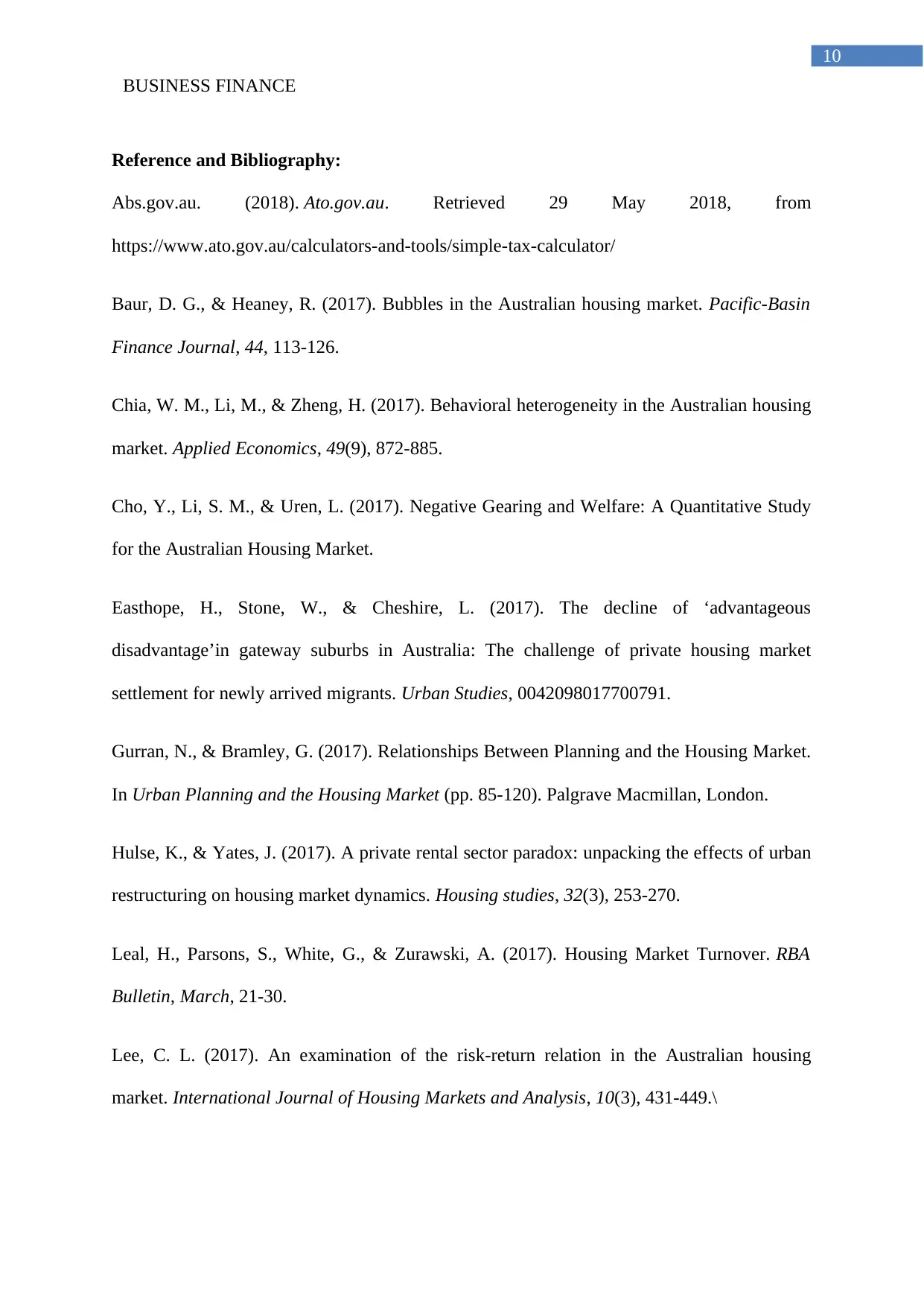
BUSINESS FINANCE
10
Reference and Bibliography:
Abs.gov.au. (2018). Ato.gov.au. Retrieved 29 May 2018, from
https://www.ato.gov.au/calculators-and-tools/simple-tax-calculator/
Baur, D. G., & Heaney, R. (2017). Bubbles in the Australian housing market. Pacific-Basin
Finance Journal, 44, 113-126.
Chia, W. M., Li, M., & Zheng, H. (2017). Behavioral heterogeneity in the Australian housing
market. Applied Economics, 49(9), 872-885.
Cho, Y., Li, S. M., & Uren, L. (2017). Negative Gearing and Welfare: A Quantitative Study
for the Australian Housing Market.
Easthope, H., Stone, W., & Cheshire, L. (2017). The decline of ‘advantageous
disadvantage’in gateway suburbs in Australia: The challenge of private housing market
settlement for newly arrived migrants. Urban Studies, 0042098017700791.
Gurran, N., & Bramley, G. (2017). Relationships Between Planning and the Housing Market.
In Urban Planning and the Housing Market (pp. 85-120). Palgrave Macmillan, London.
Hulse, K., & Yates, J. (2017). A private rental sector paradox: unpacking the effects of urban
restructuring on housing market dynamics. Housing studies, 32(3), 253-270.
Leal, H., Parsons, S., White, G., & Zurawski, A. (2017). Housing Market Turnover. RBA
Bulletin, March, 21-30.
Lee, C. L. (2017). An examination of the risk-return relation in the Australian housing
market. International Journal of Housing Markets and Analysis, 10(3), 431-449.\
10
Reference and Bibliography:
Abs.gov.au. (2018). Ato.gov.au. Retrieved 29 May 2018, from
https://www.ato.gov.au/calculators-and-tools/simple-tax-calculator/
Baur, D. G., & Heaney, R. (2017). Bubbles in the Australian housing market. Pacific-Basin
Finance Journal, 44, 113-126.
Chia, W. M., Li, M., & Zheng, H. (2017). Behavioral heterogeneity in the Australian housing
market. Applied Economics, 49(9), 872-885.
Cho, Y., Li, S. M., & Uren, L. (2017). Negative Gearing and Welfare: A Quantitative Study
for the Australian Housing Market.
Easthope, H., Stone, W., & Cheshire, L. (2017). The decline of ‘advantageous
disadvantage’in gateway suburbs in Australia: The challenge of private housing market
settlement for newly arrived migrants. Urban Studies, 0042098017700791.
Gurran, N., & Bramley, G. (2017). Relationships Between Planning and the Housing Market.
In Urban Planning and the Housing Market (pp. 85-120). Palgrave Macmillan, London.
Hulse, K., & Yates, J. (2017). A private rental sector paradox: unpacking the effects of urban
restructuring on housing market dynamics. Housing studies, 32(3), 253-270.
Leal, H., Parsons, S., White, G., & Zurawski, A. (2017). Housing Market Turnover. RBA
Bulletin, March, 21-30.
Lee, C. L. (2017). An examination of the risk-return relation in the Australian housing
market. International Journal of Housing Markets and Analysis, 10(3), 431-449.\
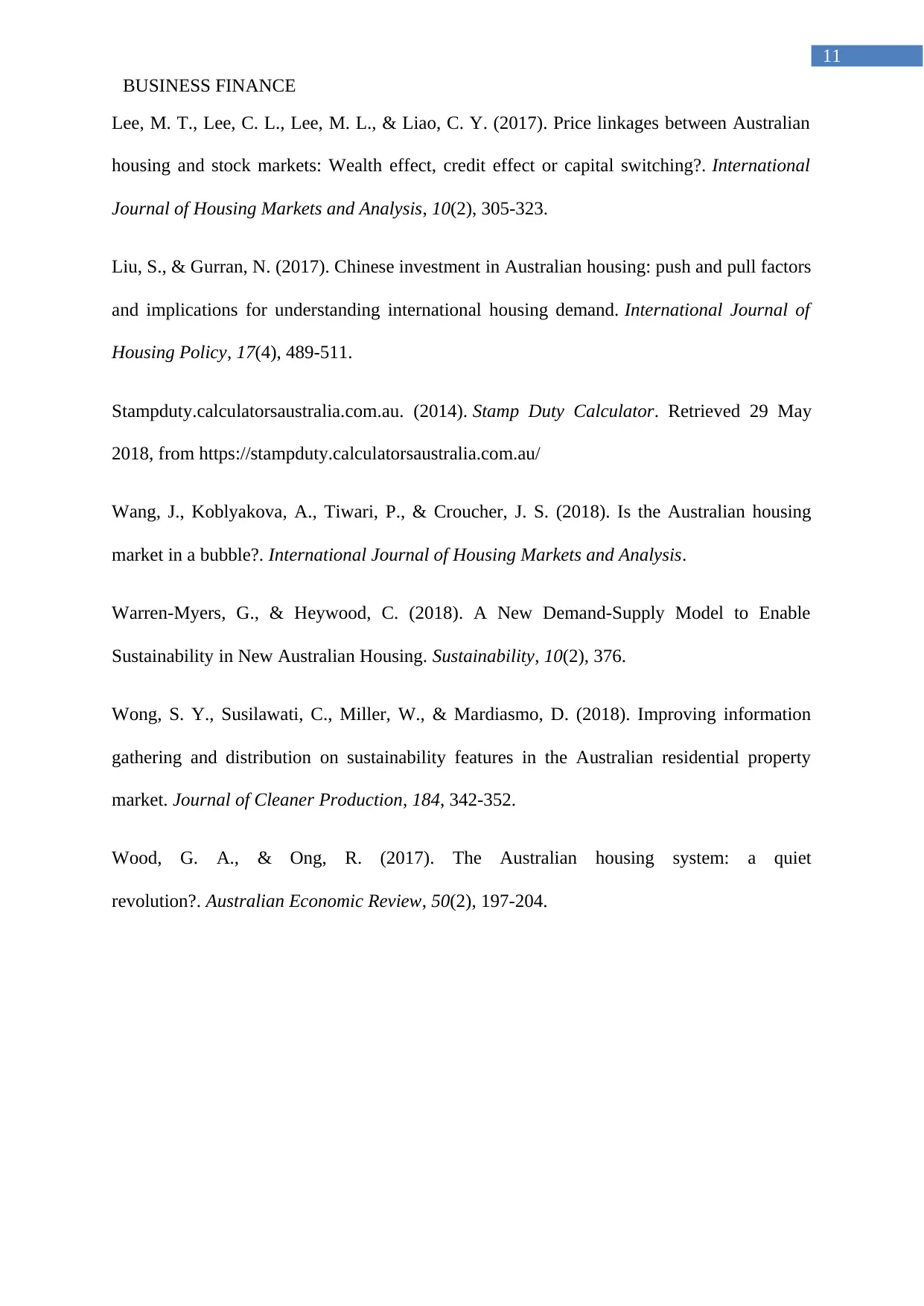
BUSINESS FINANCE
11
Lee, M. T., Lee, C. L., Lee, M. L., & Liao, C. Y. (2017). Price linkages between Australian
housing and stock markets: Wealth effect, credit effect or capital switching?. International
Journal of Housing Markets and Analysis, 10(2), 305-323.
Liu, S., & Gurran, N. (2017). Chinese investment in Australian housing: push and pull factors
and implications for understanding international housing demand. International Journal of
Housing Policy, 17(4), 489-511.
Stampduty.calculatorsaustralia.com.au. (2014). Stamp Duty Calculator. Retrieved 29 May
2018, from https://stampduty.calculatorsaustralia.com.au/
Wang, J., Koblyakova, A., Tiwari, P., & Croucher, J. S. (2018). Is the Australian housing
market in a bubble?. International Journal of Housing Markets and Analysis.
Warren-Myers, G., & Heywood, C. (2018). A New Demand-Supply Model to Enable
Sustainability in New Australian Housing. Sustainability, 10(2), 376.
Wong, S. Y., Susilawati, C., Miller, W., & Mardiasmo, D. (2018). Improving information
gathering and distribution on sustainability features in the Australian residential property
market. Journal of Cleaner Production, 184, 342-352.
Wood, G. A., & Ong, R. (2017). The Australian housing system: a quiet
revolution?. Australian Economic Review, 50(2), 197-204.
11
Lee, M. T., Lee, C. L., Lee, M. L., & Liao, C. Y. (2017). Price linkages between Australian
housing and stock markets: Wealth effect, credit effect or capital switching?. International
Journal of Housing Markets and Analysis, 10(2), 305-323.
Liu, S., & Gurran, N. (2017). Chinese investment in Australian housing: push and pull factors
and implications for understanding international housing demand. International Journal of
Housing Policy, 17(4), 489-511.
Stampduty.calculatorsaustralia.com.au. (2014). Stamp Duty Calculator. Retrieved 29 May
2018, from https://stampduty.calculatorsaustralia.com.au/
Wang, J., Koblyakova, A., Tiwari, P., & Croucher, J. S. (2018). Is the Australian housing
market in a bubble?. International Journal of Housing Markets and Analysis.
Warren-Myers, G., & Heywood, C. (2018). A New Demand-Supply Model to Enable
Sustainability in New Australian Housing. Sustainability, 10(2), 376.
Wong, S. Y., Susilawati, C., Miller, W., & Mardiasmo, D. (2018). Improving information
gathering and distribution on sustainability features in the Australian residential property
market. Journal of Cleaner Production, 184, 342-352.
Wood, G. A., & Ong, R. (2017). The Australian housing system: a quiet
revolution?. Australian Economic Review, 50(2), 197-204.
⊘ This is a preview!⊘
Do you want full access?
Subscribe today to unlock all pages.

Trusted by 1+ million students worldwide
1 out of 12
Related Documents
Your All-in-One AI-Powered Toolkit for Academic Success.
+13062052269
info@desklib.com
Available 24*7 on WhatsApp / Email
![[object Object]](/_next/static/media/star-bottom.7253800d.svg)
Unlock your academic potential
Copyright © 2020–2025 A2Z Services. All Rights Reserved. Developed and managed by ZUCOL.




